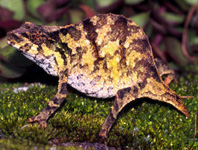Abstract
The taxonomic status of recently discovered populations of pygmy chameleons (Rhampholeon) from the northern Mozambique montane isolates of Mt. Chiperone, Mt. Mabu, Mt. Inago and Mt. Namuli are assessed, and compared with the closest geographical congeners, including Rhampholeon platyceps Günther 1893 from Mt. Mulanje, and Rh. chapmanorum Tilbury 1992 from the Malawi Hills, both in southern Malawi. Relationships were examined using morphological features and a phylogenetic analysis incorporating two mitochondrial and one nuclear marker. The phylogeny showed that each montane isolate contained a distinct, well-supported clade of chameleons. Chameleons from the Mozambican montane isolates are within a monophyletic clade inclusive of species from southern Malawi (Rh. platyceps and Rh. chapmanorum). Although some relationships are unresolved, the southern Malawi and Mozambican isolates appear to share their most recent common ancestor with species from the Eastern Arc Mountains and Southern Highlands of Tanzania and Malawi (Rh. moyeri, Rh. uluguruesis, Rh. nchisiensis). Along with Rh. beraduccii and Rh. acuminatus, all are included in the subgenus Rhinodigitum. Sister to this larger clade are species from west/central Africa (Rh. temporalis, Rh. spectrum) and the Rh. marshalli-gorongosae complex from southwest Mozambique and adjacent Zimbabwe. Morphological and molecular results confirm that Brookesia platyceps carri Loveridge 1953 is a junior subjective synonym of Rhampholeon platyceps Günther 1892. Historical records of Rh. platyceps from the Shire Highlands (Chiromo) and the Zomba Plateau, are incorrect and the species is now considered endemic to the Mulanje massif. All of the four newly discovered, isolated populations are genetically and morphologically distinct, and we take the opportunity to describe each as a new species. Rhampholeon (Rhinodigitum) maspictus sp. nov. is restricted to Mt. Mabu and distinguished by its large size, well-developed dorsal crenulations, and bright male breeding coloration; Rhampholeon (Rhinodigitum) nebulauctor sp. nov. is restricted to Mt. Chiperone and distinguished by its small size, weakly-developed dorsal crenulations, and a large rostral process in males; Rhampholeon (Rhinodigitum) tilburyi sp. nov. is restricted to Mt. Namuli and distinguished by its small size, weakly-developed dorsal crenulations, and prominent flexure of the snout in males; and Rhampholeon (Rhinodigitum) bruessoworum sp. nov. is restricted to Mt. Inago and distinguished by its small size, weakly-developed dorsal crenulations, large rostral process in males, and relatively long tail in both sexes.

